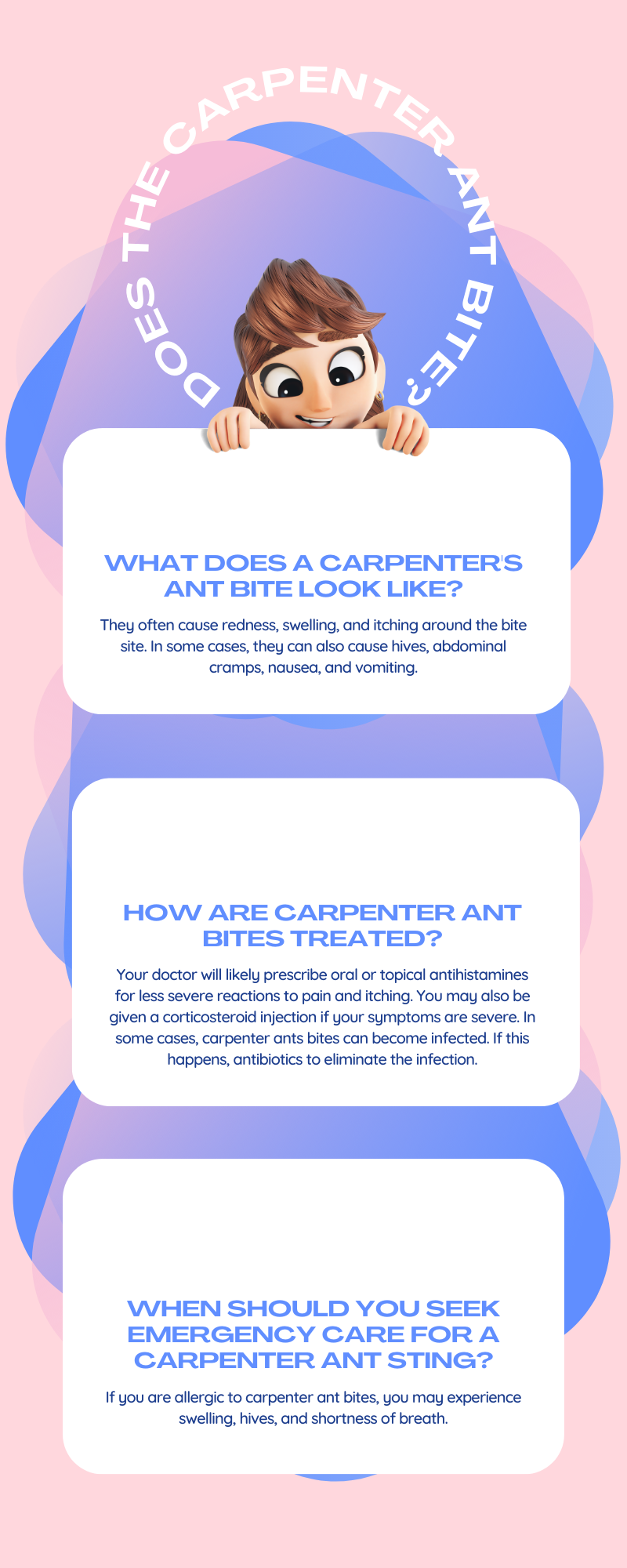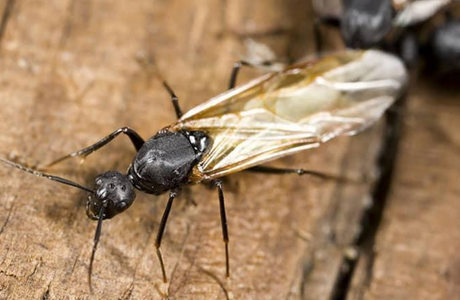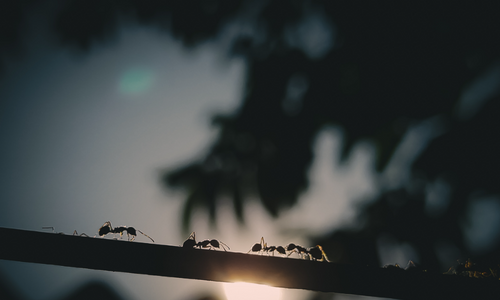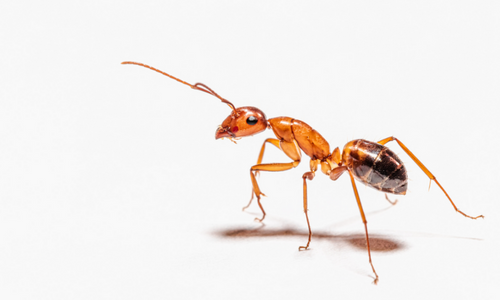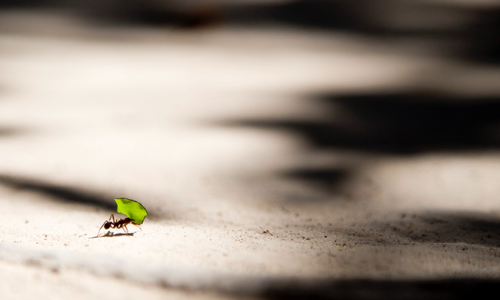Your PERSONAL ANT-CYCLOPEDIA
Carpenter Ant (Camponatus)
Carpenter Ant Scientific Classification
Phylum Belonging: Arthropods
Class of Belonging: Insects
Order To Which It Belongs: Hymenoptera
Family In Which It Is Located: Formicidae
Subfamily In Which It Is Located: Formicinae
Genus: Camponotus
Species: Camponotus
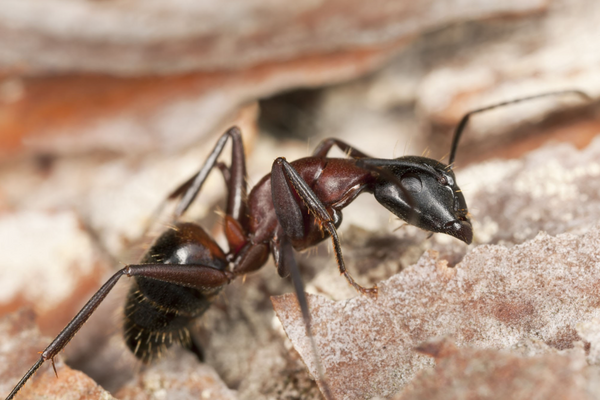
Audio Carpenter Ant 1
All You Need To Know About Carpenter Ants
When we hear about carpenter ants, we often wonder about their impact on our home or if they are dangerous to our family’s health. However, many interesting details about this arthropod can be useful to us, either to keep them away from our house or if you are interested in studying carpenter ants.
Whatever the reason you have decided to study them. We should first know carpenter ants have this characteristic name due to their affinity for chewing through the wood to form their nests. But something curious is that they do not feed on wood. This causes some people to confuse them with termites; however, these are no different from other types of ants that enjoy sweet foods and meat from other animals, such as insects or carrion.
As far as their location is concerned, carpenter ants are known to inhabit tree trunks and heavily wooded areas. But even though these areas are their favorites, they are open to more than being interested in other structures, such as old buildings, wooden doors, roofs, or house attics.
Chestnut Carpenter Ant Morphology and identification
At first glance, this ant genus can be distinguished from others thanks to its thoracic area, which normally has a convex arch shape. Between the thorax and the abdomen is a section known as the petiole. It has a single known node. In addition, we can also identify a tiny waist. The antennal area tends to bend away from the posterior edge of the clipeo.
Like most of the Formicidae family members, these ants are made up of queens, king ants, workers, and larvae. In the specific case of the workers, their actual size is relatively large, with intense black color, but not limited to this since some specimens are known to have brown, reddish, or even golden tints.
Speaking of their physical form, the workers have a large head and a small thoracic area.
In the case of ants whose objective is reproduction, these are only located in black. We refer to male and female ants.
In their physiognomy, winged ants (Female) have a small head and a much larger thoracic area. In the case of winged ants, they have transparent or brown forward wings and detach very easily.
Finally, carpenter ants’ eggs have a light cream color and are characterized by being oval.
Carpenter ant babies (Larvae) do not have appendages or legs and can be mistaken for worms. As they enter the pupal stage, they take on the appearance of silky toasted coconut.
“Pest Stats”
| Color | Black / Red / Brown / Golden |
| Legs | 6 Legs |
| Shape | Articulated antennae and well-defined waists |
| Size | 1/2 inch (1.27 cm) |
| Antennae | Articulated antennae |
| Region | Wooded areas, Nest in trees, Logs and Stumps |
What does Carpenter Ant Look Like?
Description
Carpenter ants are difficult to detect as they are “polymorphic.” This means that worker ants can be of different sizes, creating confusion with other types of ants. In queen carpenter ants, a colony commonly has a single wingless queen. When the colony reached a high degree of maturity, we can finally see the first winged females and males (around the first two years of its foundation).
Carpenter worker ants are black, dark brown, red, black, yellow, or red, measuring 3.4–13 mm. Black carpenter ants possess dark brown and black uniform colors, whereas red and black carpenter ants possess dark brown and black bodies with reddish brown thorax.
There are numerous species of carpenter ants in the United States, so size and color are only sometimes reliable identification properties. Carpenter ants are distinguished from other species by the rounded profile of their thorax, the heart-shaped head, and the circle of hairs around the year. (These identifying properties are best seen under magnification.)
Queen carpenter ants and breeding males have forewings larger than hindwings. These wings are transparent or light brown. Winged carpenter ants appear in spring or fall. After fertilizing the females, they make a nest to form a colony.
Carpenter ants’ eggs are oval in shape and cream in color. Carpenter ant larvae do not have legs. Throughout the pupal stage, they develop into adult ants.
Geographical distribution
Carpenter Ant Distribution Map In Us
Carpenter Ant California
Carpenter Ants Texas
Carpenter Ant Florida
Carpenter Ants Jacksonville Fl
Carpenter Ant Georgia
Carpenter Ant Michigan
Carpenter Ant Oregon
Carpenter Ant Utah
Carpenter Ants New York
Carpenter Ant Distribution By Country
carpenter ant in japan
carpenter ant uk
carpenter ants new Zealand
carpenter ant costa rica
Carpenter Ant Distribution By Continent
Carpenter Ant Asia
Carpenter Ant America (American Carpenter Ant)
Carpenter Ant Africa
Carpenter Ant Europe
Carpenter Ant Map




Join The Ant Farming Club!
If you are looking for an Ant Farm and you don’t know which one to choose, or on the other hand you already have your first ant farm, but you don’t know how to grow your colony, take care of it or feed it. Here we offer you the best tips and products to make your colony grow healthy and strong.
In the next section, you will also find advice from professionals to choose the best products on the market such as:
- Luminous Gel
- Ant Farm Sand
- LED light
- Live Ants
- Full Ant Farm Kits For Kids
Ant Farming Club is perfect for kids wanting their first ant farm or schoolteachers wanting to show their students the biology of ants in a natural habitat.
Join
Join and learn all about the world of ants and ant farming.
Products & Discounts
Find discounts and advice from professionals about the best products on the market in 2022.
Meet
Connect with people who are passionate about the world of entomology.
Do Carpenter Ant Bite?
Does the carpenter ant bite?
Carpenter ants are one of the most feared pests in the world, not only because of their ability to adapt easily to almost any environment but because of their bites, which are incredibly painful and can cause severe allergic reactions.
Suppose you are unlucky enough to be bitten by one of these ants. In that case, it is important to seek immediate medical treatment, especially if you are sensitive to insect bites or were attacked by a large colony by mistake.
If carpenter ants have bitten you, here’s what you need to know about bites, including what they look like, how to treat them, and when to seek emergency medical attention.
What does a carpenter’s ant bite look like?
Carpenter ants bites are large and very painful. They often cause redness, swelling, and itching around the bite site. In some cases, they can also cause hives, abdominal cramps, nausea, and vomiting. If you have a severe reaction to a carpenter ant bite, you may also experience swelling of your face, lips, or throat, difficulty breathing, and shock.
How are carpenter ant bites treated?
If a carpenter ant bites you, it is important to seek medical treatment immediately. You may need emergency care if you have a severe reaction to the sting. Your doctor will likely prescribe oral or topical antihistamines for less severe reactions to pain and itching. You may also be given a corticosteroid injection if your symptoms are severe. In some cases, carpenter ants bites can become infected. If this happens, antibiotics to eliminate the infection.
When should you seek emergency care for a carpenter ant sting?
A carpenter’s ant bite usually looks like a small red bump on the skin. The lump can be painful or itchy, but it’s generally not serious. However, some people can have a severe allergic reaction to a carpenter’s ant bite, which can be dangerous. If you are allergic to carpenter ant bites, you may experience swelling, hives, and shortness of breath. You should seek emergency medical treatment immediately if you have a severe reaction.
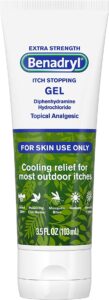
About this item
- Benadryl Extra-Strength Anti-Itch Gel temporarily relieves pain and itching associated with insect bites, minor burns, sunburn, minor skin irritations and rashes due to poison ivy, poison oak and poison sumac.
- Topical analgesic gel provides cooling, anti-itch relief from most minor pains and outdoor itches associated with insect bites.
- The cooling gel provides the relief of pain and itching associated with insect bites.

More Immediate Treatment management:
Carpenter ants can be eliminated in several ways:
Repair areas with moist wood and plug leaks near the colony.
Your home should be kept away from wood piles and other lumber.
Keep plants and trees away from your house to prevent ants from crawling inside.
When your windows are closed, seal any cracks.
To remove ants, use an ant spray or a homemade solution containing boric acid, water, and sugar. Keep these solutions away from children and pets.
If these methods do not work, you should contact a professional to get rid of a carpenter ant colony.
Long-term Treatment management:
How to Control Carpenter Ants in the House?
Eliminate their food sources: Make sure to keep your kitchen and pantry free from any crumbs or spills. Also, try not to leave any food out on the counter for long periods of time, as this can attract carpenter ants. 2. Find and seal off their entry points: Look for any holes or cracks in the walls and ceilings, around doors and windows, etc., that may be providing access into your home for the carpenter ants. Use caulk or other appropriate sealants to plug these potential entry points up tight! 3. Set ant baits: Ant baits are specially designed traps that contain a slow-acting poison targeted at eliminating entire colonies of ants over time. Place several near areas where you’ve noticed carpenter ant activity in order to slowly reduce their numbers over time without killing them all at once (and potentially causing an infestation). 4. Utilize insecticides: If you’re looking for an immediate effect against carpenter ants, then consider using insecticides such as sprays or dust instead of relying solely on bait methods – although it is important to make sure that whatever product you use is safe for indoor application if necessary!
Common Areas of Carpenter Ant Infestation in Homes
1. Kitchen: Carpenter ants are tempted to food sources, so it is typical to find them where food is prepared and stored, such as in kitchens.2. Bathroom: Moisture-prone areas, like bathrooms, can also be a target for carpenter ant nests since they require moisture to survive.
3. Basements and crawl spaces: These dark and damp locations provide the ideal environment for carpenter ants to build colonies or nesting sites beneath floors or behind walls that separate living spaces from the outdoors.
4. Attics: Since attics are warm and often have plenty of wood available, they make great spots for carpenter ants to establish their homes and breed.
5. Windowsills: Carpenter ants may use these small spaces as easy access points into your home through cracks or crevices around windowsills.
What Attracts Carpenter Ants to Your Home?
Carpenter ants are attracted to damp wood and commonly infest homes through cavities in the foundation, deteriorating wood, closed windowsills or door edges, and water damage. They frequently penetrate houses through cracks in the walls or soffits with a large tree branch nearby. Inside houses, carpenter ants are normally found near sources of moisture, such as bathrooms, kitchens and basements. If conditions are right, they may also be attracted to leaky pipes or condensation on window sills. Food scraps are left around to draw them, too; sugary items like honeycomb cereals provide a sweet treat for these pesky insects!
The Dangers of a Carpenter Ant Infestation
Structural Damage: Carpenter ants can cause extensive structural damage to buildings and other structures by excavating tunnels in wood beams or posts, weakening them over time.Contamination: These ants tend to contaminate food sources with their faeces, which can spread disease and illness if the contamination is not dealt with promptly.
Health Hazards: In some cases, carpenter ant bite may cause skin irritation or an allergic reaction that requires medical attention. These pests also carry bacteria on their bodies that could transmit diseases if ingested through contact with food sources or open wounds on humans and animals alike.
Unwanted Noise: Carpenter ants are nocturnal creatures who make loud clicking noises as they communicate at night, disrupting people trying to sleep or concentrate during quiet hours of the day or night. This can become extremely irritating, especially when it repeatedly happens multiple nights!
YOU CAN ALSO LISTEN HERE!
Audio Carpenter Ant 2
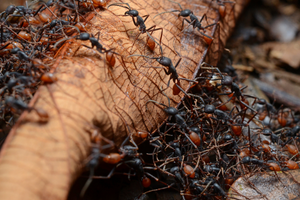

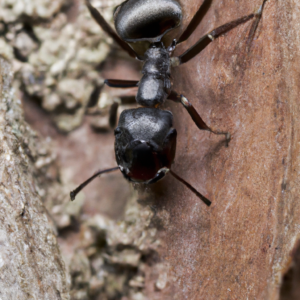
Natural Behavior Carpenter Ant
Carpenter ants are social insects that live in large colonies and work together to create nests. Their nests can be found in trees, walls, attics, or other wooden structures.
Carpenter ants communicate through pheromones and use their mandibles to cut away wood as they form galleries to construct their nest.
They feed on various food sources, including honeydew from aphids, dead insects, sweets such as syrup or sugar cubes, and small pieces of meat.
Carpenter ant alate anatomy
Their anatomy consists of three body parts;
- The head
- Thorax
- And abdomen.
The carpenter’s ant’s head is equipped with strong mandibles for cutting through wood material when building nests and two antennae that allow them to detect smells and touch stimuli. The thorax contains a pair of legs, while the abdomen includes an ovipositor (egg-laying tube) at its tip, which helps carpenter ants lay eggs within their colony’s chambers. It also has anal windows that produce pheromones used for communication between members of the same species.
Regarding activity levels, carpenter ants are most active during twilight, such as dusk or dawn. However, they may still be seen during the daytime if nearby food resources are available, such as open garbage cans or pet dishes filled with leftovers.
They don’t hibernate like some other ant species so you can see them even during winter, depending on weather conditions. Adaptations help carpenter ants thrive in their environment by giving them certain advantages over other species competing for food sources, such as air circulation provided by tunnels they have dug out inside tree trunks, walls, etc… which keeps them cool.
Reproductive Cycle of the Carpenter
The Carpenter ants have a higher reproductive rate than many insect families due to multiple queens per colony, allowing more larvae production and chemical defense systems composed mostly of formic acid released from glands around their heads whenever they feel threatened.
Carpenter ant larvae
Carpenter ant babies/larvae look similar to adult worker ants. However, they lack wings which will develop once the pupae stage is complete.
Characteristics include being wingless until adulthood but having powerful jaws capable o chewing through hard materials easily, making it easier for them to build complex nesting sites inside tree trunks, walls, etc… Colony size varies widely depending upon how long the colony has been established and what type of resources are available nearby ranging anywhere from hundreds up into thousands. The diet consists mainly of good sources listed above plus scavenging on occasionally leftovers.
Carpenter Ant Colony structure
Carpenter ants are one of the most common ant species found in North America, and they can cause a lot of damage to wooden structures. If a carpenter ant colony is established near or inside your home, you will likely experience network damage and health issues. Therefore, it’s important to know about the structure of the carpenter ant colony so that you can properly identify and address any infestations in your home. In this blog post, we’ll discuss everything you need to know about the structure of a carpenter ant colony:
- How they establish their territories.
- What they look for in a nesting site.
- How they reproduce.
By understanding these elements, we can more effectively take steps towards preventing or removing an existing carpenter ant colony from our homes.
The Different Types of Carpenter Ant Colonies
Carpenter ants are found in many different types of colonies, each with their unique structure. The most common type of colony is the monogyne colony, which consists of a single queen and many worker ants. However, there are polygyne colonies, which have multiple queens, and ergatoid colonies, which have no queens.
The size of a carpenter ant colony can range from just a few hundred ants to tens of thousands of ants. The largest known settlement in the Brazilian rainforest contained over 30 million ants!
Carpenter ants colonies typically live in rotting trees or logs but can also be found in houses and other man-made structures. Carpenter ants are one of the most common ants that invade homes. They are attracted to moisture and often enter through cracks or holes in the foundation.
Once inside, carpenter ants build their nests in soft or damaged wood. They prefer to nest in structural timbers such as joists, rafters, and studs. Carpenter ants do not eat wood like termites; instead, they excavate it to create smooth tunnels and chambers for their nests.
The damage caused by carpenter ants can be significant if left untreated.
The Life Cycle of Carpenter Ants
Carpenter ants go through three main stages in their life cycle: egg, larvae, and adult. The egg stage lasts for about two weeks. During this time, the eggs hatch, and the larvae develop. The larvae stage lasts for about six weeks. During this time, the larvae molt four times and grow into adults. The adult stage lasts the rest of the ant’s life, typically about two years.
What do Carpenter Ants Eat?
Carpenter ants are predators and scavengers that feed on other insects and small animals. They especially like sweet foods like honeydew, nectar, and fruit. However, they will eat almost anything else they can find, including other ants, dead insects, and even small mammals.
Seasonal Colony Trends [All You Should know]
Carpenter Ant Reproduction (Reproductive Biology)
Carpenter ants reproduce through a process known as nuptial flight. This occurs when sexually mature individuals, called reproductive alates or swarmers, leave their parent colony to mate and establish new colonies. During this time, both sexes release pheromones which act like “signals” for other ants of the same species. When a male ant finds an interested female, he will transfer sperm from his genital opening into her body, where it is stored until she needs it to fertilize eggs while setting up her own colony.
This is where the journey of the new queen begins.
The female ants then peek for an unexplored place to construct their colonies. The queen carpenter ant usually examines a small gap in a wooden composition. She then covers herself in said chamber and lays the first batch of eggs. She stays in the room until the first batch of eggs from her hatch into adult workers. The queen uses her stored fat reserves and wing muscles for nourishment.
The queen feeds the young using her salivary glands until they become workers capable of foraging. The queen takes care of her first brood, and when she grows up, said first brood of adult workers takes care of the subsequent brood.
3-6 years are required to establish a huge and stable colony. The lifespan of a carpenter ant is believed to be 6 to 12 weeks from egg to maturity. Frigid weather can extend the developmental era of carpenter ants by up to 10 months.
The sole role of the queen carpenter ant is to lay eggs, but as soon as the worker carpenter ants mature into adults, they take over the responsibilities of the colony. They forage for food, care for eggs, larvae, and pupae, and burrow to expand and spread their nest. Functionalities are separated into two castes: larger workers who work as soldiers to defend the nest and smaller workers who forage for food and care for the young.
After two or more years, the queen generates winged males and females that leave to start other carpenter ant colonies. A traditional carpenter ant colony has a queen.
Interesting Fact About Carpenter Ants
The queen may lay thousands of eggs over her lifetime, with only about half maturing into adults due to environmental factors such as temperature, humidity, and availability of food sources.
Carpenter Ants, Economic Impact
It’s no secret to anyone that ants have an incredible ability to adapt and find ways to coexist with other organisms in amazing ways. Unfortunately, this is not something that they do not get at a high price, especially when we are talking about our properties.
Studies have concluded that Carpenter ants can cause significant economic damage to homes, buildings, and other structures.
They do not do it to destroy but in search of the necessary resources to existing. As they forage for food, these large black or reddish ants chew through wood, creating tunnel galleries along structural beams, support beams, and wall studs. These large tunnels weaken the structure of a house or building, leading to expensive repairs.
In the United States alone, damage from carpenter ant infestations can cost the average family thousands of dollars annually for repair work.
Carpenter Ant Environmental impact
Another of the great impacts that carpenter ants can generate is environmental, in an area where they do not originate. It is known that invasive ants or those forcibly introduced can harm the local fauna, especially if it is very different for these arthropods.
Research has concluded that carpenter ants can cause significant environmental impacts on forests and wooded ecosystems. They are particularly attracted to damaged trees with insect infestations or damaged branches that provide easy access to the tree core, where they can create their nests and feed on decaying soft wood tissue within the inner layers of the tree.
Over time, this activity can weaken the physical integrity of these trees, making them more prone to tipping over during heavy storms and reducing full canopy cover, which is essential for maintaining diverse habitats that support other wildlife species that depend on healthy trees as key sources of energy and shelter, as well as protection from predators.
We must be very careful with the way we treat these insects and always think about the potential impact they could have if we decide to release them. If you have ants that are not native to an area, you should not, under any circumstances, release them into the local fauna.
Remember that carpenter ants are territorial and will attack other organisms with hostility.

Funny Fact About Carpenter Ant
Carpenter ants are capable of surviving underwater for up to 24 hours.

Water temperature is the most important determining factor, with lower water temperatures facilitating longer survival times.
Ants live in basically every terrestrial habitat on Earth. Periodically, an ant’s habitat is subject to flooding, or the ant must transit a body of water during foraging. Ants, like many insects, breathe via specialized spaces in the abdomen. Carpenter ants can close these spiracles during water submergence and lower vital bodily functions, entering a torpor-like state. In this state, the ant needs 20 times less oxygen while sleeping. The lower the water temperature, the easier it is for the ant to preserve this lower metabolism and the longer it prevails below water.
In some events, Carpenter ants permit an air bubble to form around their abdomen, enabling them to obtain oxygen while underwater for a short period. One species of Australian ant, Polyrhachis Sokolova, lives in a nest in mangrove mud. These nests frequently flood for up to 3.5 hours at a time. To cope with the flooding, the Polyrhachis build air pockets into their nests, allowing the ants to remain in the nest until the water subsides.
Carpenter Ant Photos And Pictures
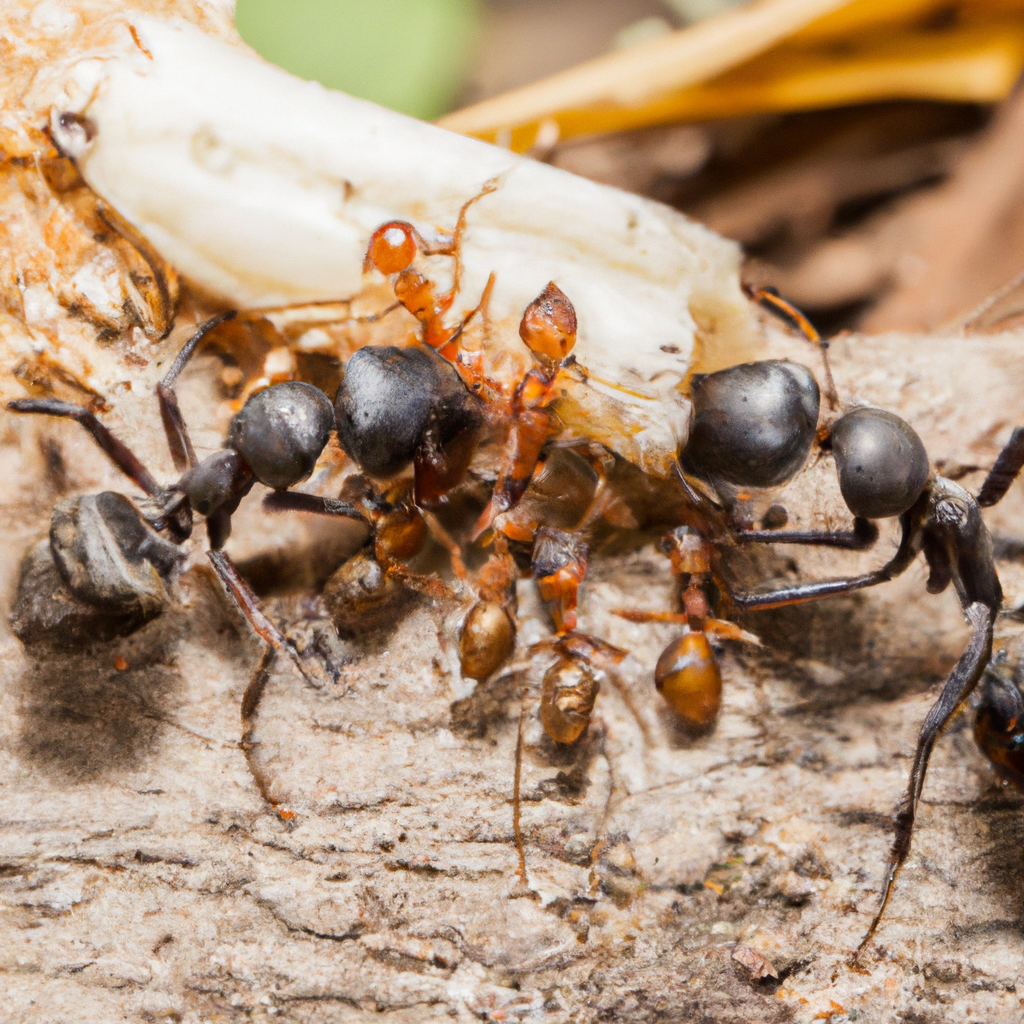
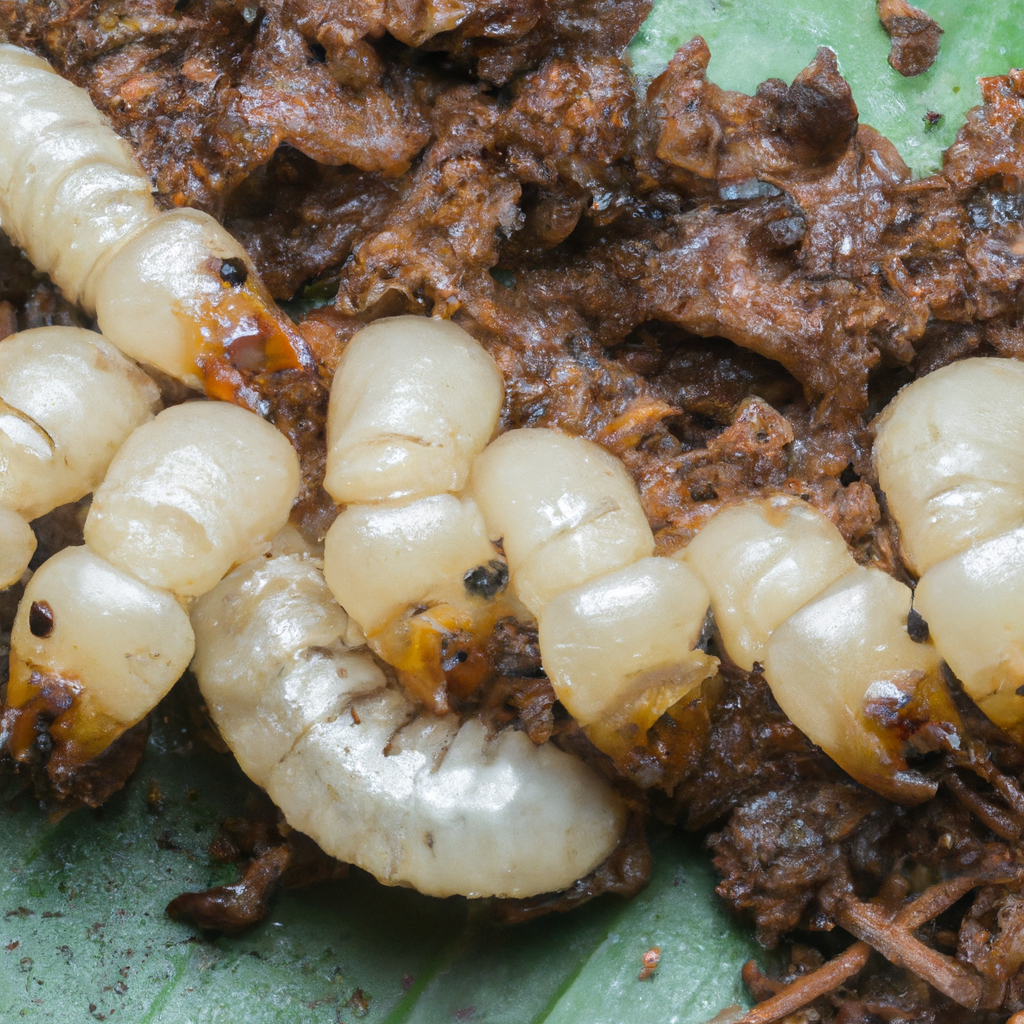
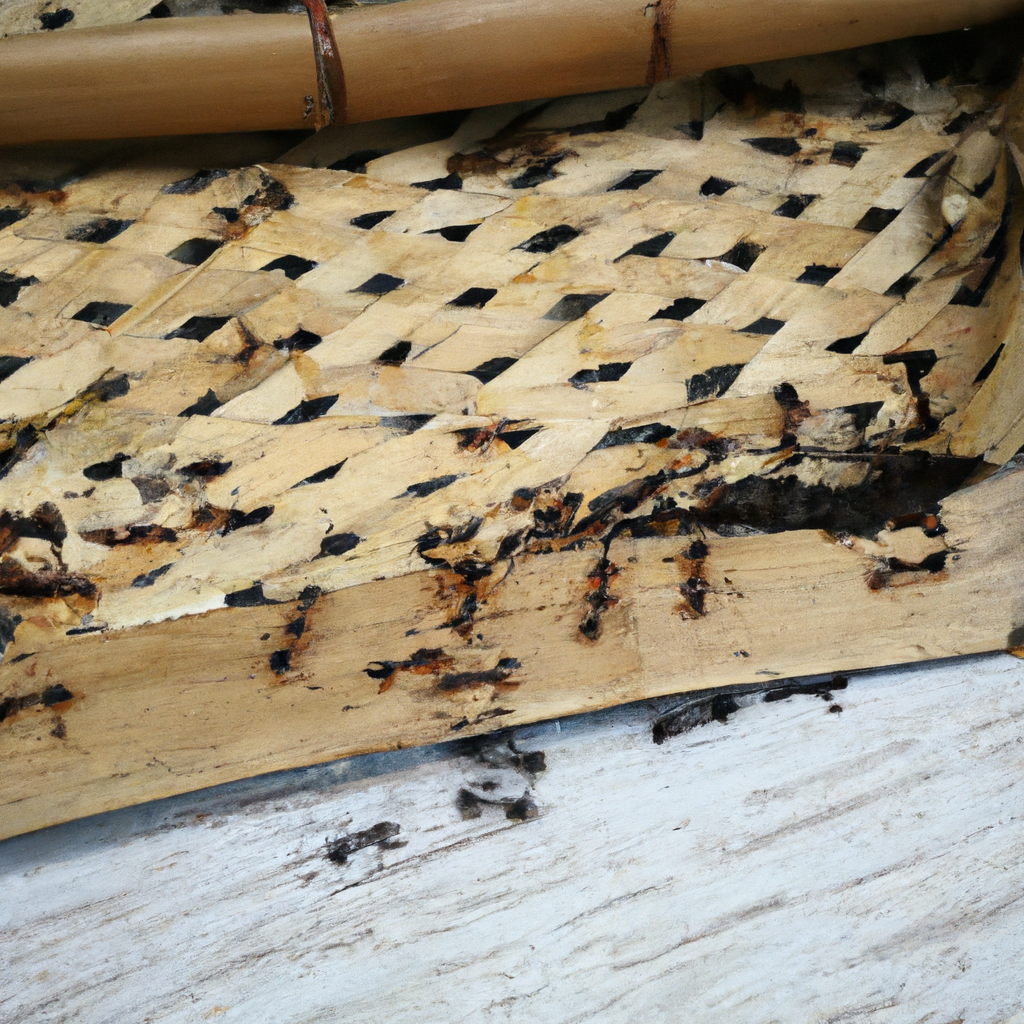
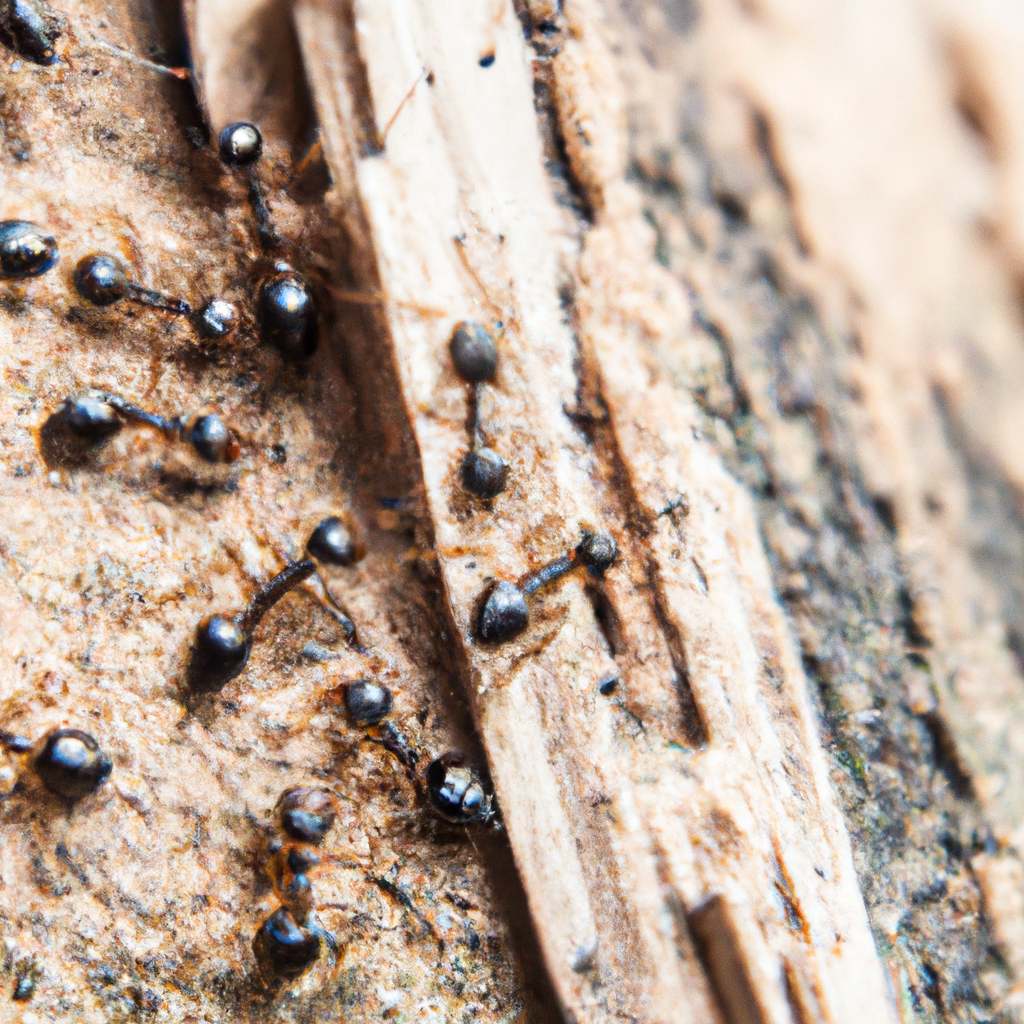
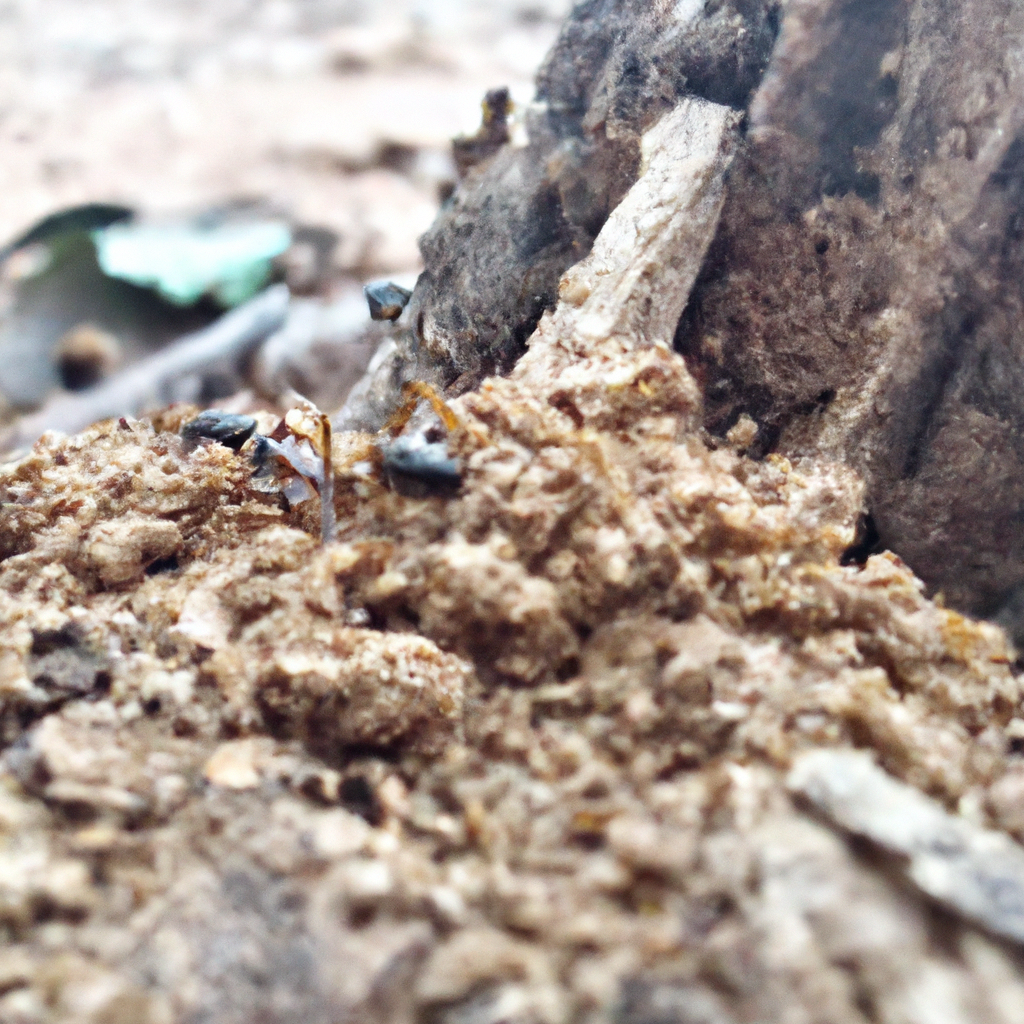

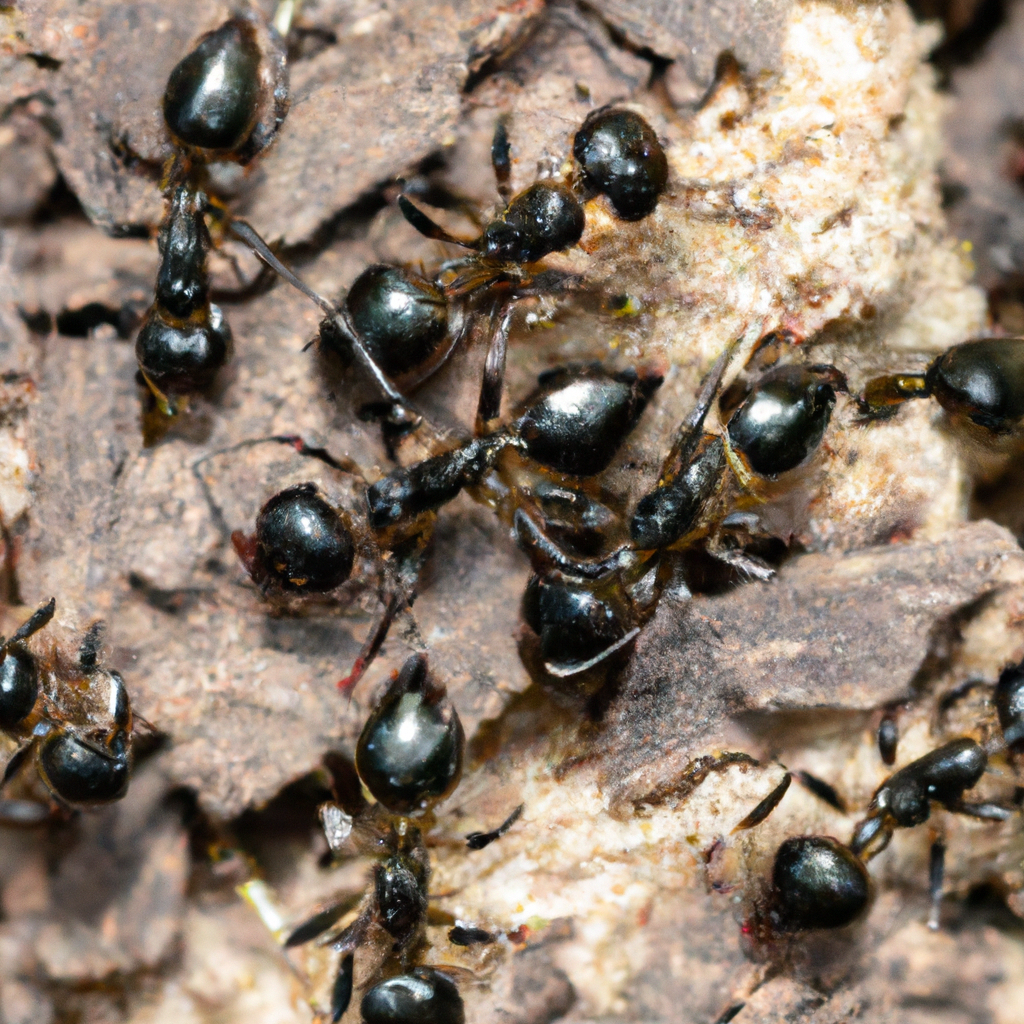

YOU CAN ALSO LISTEN HERE!
Audio Carpenter Ant 3
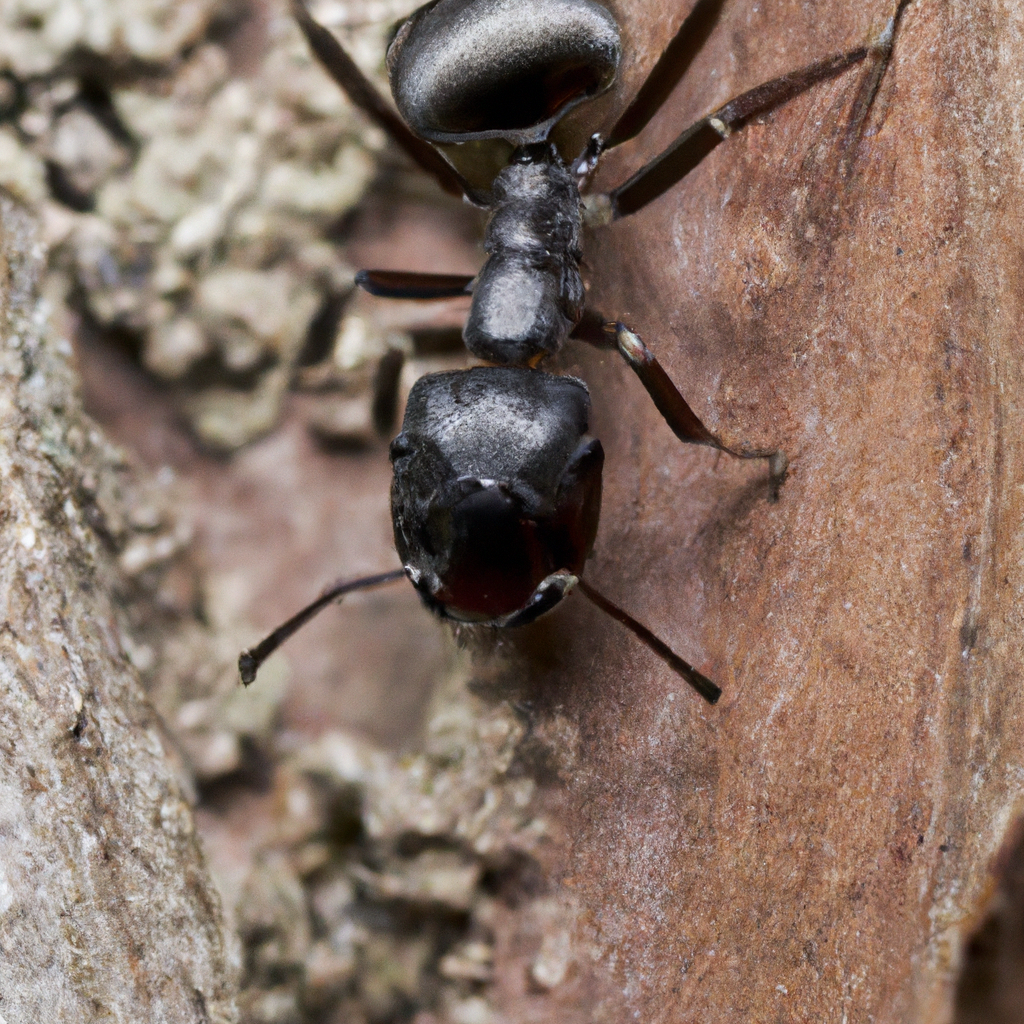

Carpenter Ant Education
Habits
Like most creatures on our planet, the carpenter ant enjoys characteristic habits of its species, such as socialization and colony construction. But to achieve this, they need a large number of food sources.
Carpenter Ant Nutrition And Diet
Among the various food sources, we can find proteins such as other insects, honeydew (a sweet liquid produced by aphids), and plant material such as fruits and nuts.
They also need moisture to survive in water-soaked wood or sources of moist soil.
When searching for food, carpenter ants often follow the trails established by other ants that have already discovered potential prey. This means they often form large colonies with many workers foraging for food in different directions from the nest.
Regarding the care of young larvae and eggs, carpenter ant queens lay their eggs in specially designed chambers within the nest structure where the humidity is high enough for them to develop properly until they hatch into larvae. Once hatched, worker ants feed these larvae regurgitated fluids (including partially digested plant matter) until they develop into the pupal stage before emerging as adult workers.
But their habits are not limited to reproduction and feeding. As we already mentioned above. Carpenter ants are highly intelligent and eusocial. Therefore, interaction and communication are essential to their lives, and the construction of complex housing structures will allow the following generations to expand and conquer.
Carpenter Ant Habitat
- Yellow Carpenter ants prefer to nest in damp, rotting wood.
- They often build their nests in trees, stumps, and logs exposed to moisture.
- They can also nest within the walls of homes or buildings if decay occurs.
- Carpenter ants may also move indoors, looking for food sources such as sweets, meat, and grease.
Threats To Humans (Carpenter Ant ants harmful?)
Yes, carpenter ants can be harmful to humans. They are known to cause structural damage to buildings and other structures by creating nesting galleries within these materials. While ants themselves do not bite or sting, their presence can indirectly lead to health risks if left untreated due to possible allergens caused by excrement (a mixture of waste made by ants) and mold that can form in your path.
Carpenter Ant Queens
Carpenter ant colonies typically consist of a queen, her assistants (or worker ants), and several thousand offspring. The queen is the only ant that lays eggs, developing into a colony’s babies or workers.
The life cycle begins with an egg laid by the queen. After hatching, the larvae undergo three stages before pupating, a non-feeding phase in which they transition between larval and adult forms.
During this time, the worker ants will care for and groom the pupae as they develop wings to fly off as adults, ready to start a new colony! When ready to depart after completing its metamorphosis process, each ant takes its first flight in what is called “the nuptial flight.” They will then find another suitable location near or far from where they hatched to establish a new nest/colony made up mostly of their species, depending on availability at that location! Once there and found, remoteness kicks in, and most colonies often stay put unless disturbed due to environmental changes or human intervention like construction work, etc.
In some cases, if too many disturbances occur nearby, a colony might choose to migrate as well; but such cases are quite rare and not very common among carpenter ants!
The Best Products 2023
Formicarium
Formicarium
Ant Farm
Ecosystem
Entomology supplies
Test Tube Packs
Pipettes
Feeding Dishes
Ant Foods
Ant Nectar
Feeders
Eco-Fresh Rice Worms
Fly Larvae
Kits
Terrarios
Nest Kit
Ant Farm Sand
Ant Farm Neon Gel
YOU CAN ALSO LISTEN HERE!
Audio Carpenter Ant 4
Carpenter Ant Pest Prevention & Control
Prevention
1. Eliminate sources of moisture by fixing leaking faucets, pipes, and air conditioning units.
2. Trim trees and shrubs away from your house to prevent Carpenter ants from entering through branches that touch the structure.
3. Seal all cracks in your foundation or exterior walls with a caulk made for indoor/outdoor use.
4. Install door sweeps on exterior doors to reduce Carpenter ant entry points into the home.
5. Store firewood and other organic materials at least 15-20 feet away from your home’s foundation to discourage ant activity near the house’s perimeter
6. Clean up spills immediately and keep food stored in sealed containers so it doesn’t attract ants indoors or outdoors
7 . Use sticky carpenter ant traps along baseboards or windowsills as an early detection tool for carpenter ant infestations
8 . When necessary, apply insecticide specks of dust along windowsills, attic eaves, crawl spaces, and other hard-to-reach places where carpenter ants may take up residence
Carpenter ants vs termites
Carpenter ants and termites are wood-destroying pests but differ in critical ways. Carpenter ants don’t eat wood. Instead, they tunnel through it to make nests. They have many food sources, including honeydew from aphids and insects and meats and sweets found inside homes. Termites, on the other hand, live off cellulose materials like wood that they digest with the help of bacteria in their gut. They form large colonies within structures and can cause significant damage if left untreated.
Wanna learn more about Ants? Join an Online Community of more than 1000 Readers Around the Country.
Here you can sign in to our newsletter to receive daily emails with funny facts, interesting details about ants, step-by-step tutorials, and even good practices to have a healthy ant farm colony. We’ll be more than happy to have you in…

Now, if the carpenter ants have broken into your home, wreaking havoc in every corner of your house. You are probably looking for effective steps to control ant infestations. If that is your case, the following steps may be useful to eliminate carpenter ants.
How to Get Rid of Carpenter Ant (Easy Steps)
1 – First Step: Inspection & Control
How To Find Carpenter Ant Nest?
1. Locate the ant nests or entry points into your home. Carpenter ants usually nest in moist wood and can be found outdoors in tree stumps, old logs, dead branches, decks and foundations. Inside homes, they often nest in hollow doors, window frames and wall voids near water sources such as sinks or leaks.
2. Eliminate moisture sources around the building foundation to discourage carpenter ants from entering your home or business premises (such as diverting rainwater from the structure).
3. Seal up cracks and crevices where carpenter ants may enter with caulk or weather stripping material; ensure that all screens are properly fitted to windows and outdoor vents to keep out pests like carpenter ants.
2 – Second Step: Natural Methods To get rid of Carpenter Ant
Outdoor And Indoor Organic Pest Control Products
Diatomaceous Earth
Diatomaceous Earth is a naturally occurring soft sedimentary rock that has been ground down to a fine white powder.
This powder damages the exoskeleton of insects, so it acts as a barrier that Carpenter ants won’t cross.
If you have potted plants on a shelf, you can put a small amount of diatomaceous earth down by the legs of the shelf, preventing ants from getting up onto the plants.
These barriers can be put virtually anywhere, both indoors and outdoors.
While Diatomaceous earth is safe for humans to handle and even eat, it does create fine dust that should not be inhaled.

PROS About Diatomaceous Earth
Among its most striking advantages is the low risk to the health of people, children, and pets, as well as the residual years that this compound can have in our home, providing extra protection against pests. This material is not recommended for use on carpets or floors that you would vacuum.
CONS About Diatomaceous Earth
Although this product represents a non-chemical solution to avoid chemical pesticides. This powder can have some drawbacks. An example of this is that insects need to have direct contact with the material, as well as prolonged contact for it to have a greater effect. This means, that if we decide to use this. We must distribute it throughout our home in large quantities. On the other hand, Diatomaceous Earth must be kept dry, so it is not a good idea if we want to use it in our gardens that are damp from irrigation.
Despite its low toxicity. This material could not be used to kill ants if it did not have some level of danger to the health of insects, so the use of dust masks is recommended, as well as applying it in ventilated areas since this dust could cling to the mucous membranes of the nose and mouth. Also, the dust could fly and generate allergies if we apply it in places where there are fans or air conditioning.
Boric Acid
Boric Acid is a type of Acid found in many naturally occurring minerals, such as borax. Borax is found in many cleaning products, including some types of toothpaste.
Boric Acid has a very low toxicity level for mammals but not for ants. It interferes with their digestive system and slowly terminates them.
The trick is to keep the level of boric Acid low enough so that it travels through the colony and makes it to the queens and young before killing the ants.
I will give you a personal recommendation of a product that is currently on the market called Terro. This contains borax, and I found it effective against Carpenter ants.
You can also find recipes online to make your own carpenter ant bait at home using borax. (Here are the steps if you are interested)
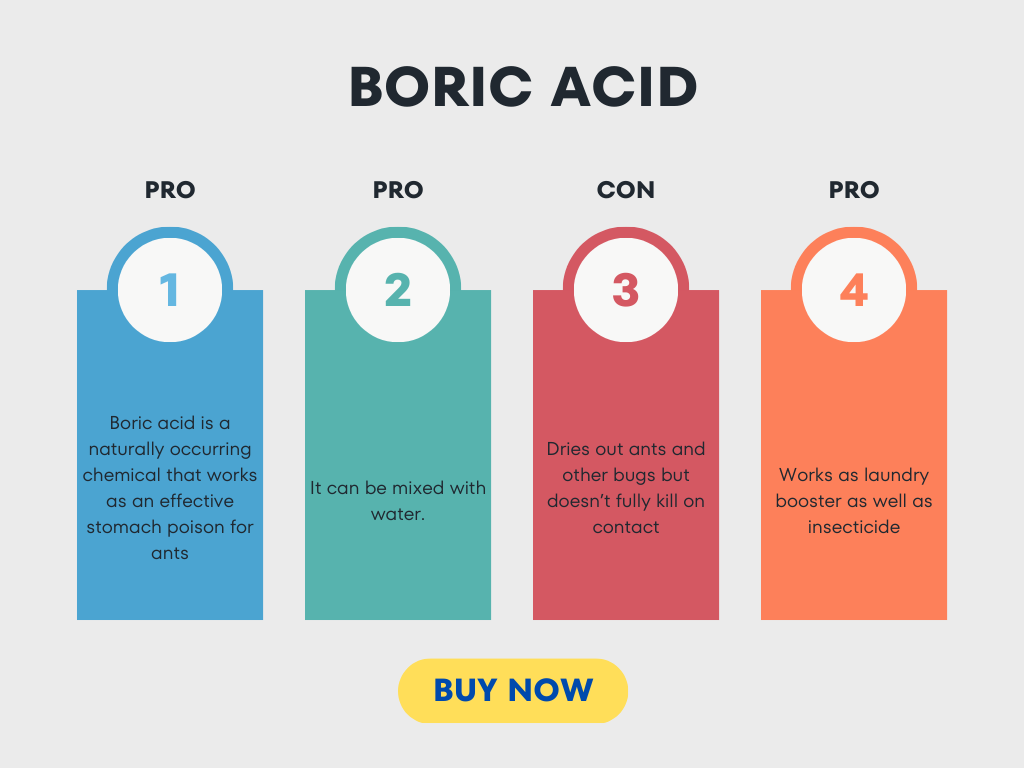
PROS About Boric Acid
This product dissolves easily in water, which allows us significant savings. On the other hand, it is more granular than powder. Which makes it less likely that we will inhale it by mistake.
It is useful for other types of pests, such as cockroaches.
CONS About Boric Acid
In very humid climates, if not stored properly, it can become damp and ruined. Therefore, it is recommended to store the mixture in a gallon Ziploc bag to keep it dry and protected when not in use.
Essential oils
Carpenter ants communicate with each other using pheromones. A forager that finds food marks a trail on the way back to the colony. This scent trail is followed by other ants, and these ants then reinforce the trail when they head back to the colony with food.
Pheromones also help ants tell each other apart, warn each other of danger and communicate all sorts of messages we’re only beginning to understand.
Most essential oils have a very strong fragrance. We can use this strong fragrance to mask pheromone trails and disrupt the coordination of ants. This method, in addition to being very efficient, allows you to drive away the ants in a natural way without causing them harm.
Essential oils can be added to soapy water that can be used to clean pots and shelves where we keep cacti and succulents. This will mask any previous messages ants left behind to tell other ants… HEY! There is a good food source, water, or shelter.
My Favorite essential oils to use for ants are:
- Peppermint
- Cedarwood
- Lemongrass and
- Clover
However, there is a high range of essential oils that we can use to keep ants away from our homes. Below we offer you a select list of the most efficient oils with the best results on the market.

Pros About Essential Oils
These essential oils represent rapid elimination and residual repellency. which means many months of additional protection.
On the other hand, this represents a highly respectful pest control with our environment.
In the case of living with other beneficial insects for us, such as bees or other pest-control insects. These represent minimal risk.
Finally, as we all know. Essential oils offer us a natural and pleasant fragrance for our home.
Cons About Essential Oils
Essential oils are very useful for many purposes despite their effectiveness in pest control. We may need large amounts to eradicate large ant colonies. Essential oils are expensive, so it can cost us a few dollars to completely eradicate an ant colony.
3 – Third Step: Insecticides and Ant Baits To Control Carpenter Ant (Best Carpenter Ant Killer)
Best Ant Bait For Carpenter Ant
- Baits (protein/fat-based baits).
- Honeydew Aphid Baits
- nectar baits
- Plant product bait gel as well as sugary carbohydrates.
Carpenter Ant Control Using Insecticides
Treat infested areas with insecticide dust labelled for use against carpenter ants (follow instructions on the product label for proper application) — note that some homeowners opt for professional pest control services instead of DIY treatments due to potential health risks associated with insecticides/pesticides use when not handled correctly
Pesticide
Carpenter Ant Control Using Pesticides
1. Ensure you have identified the correct ant species before applying any pesticide to ensure effective treatment.
2. Use a speck of insecticide dust as a surface treatment or spray indoors and around windows, doors, foundations and other areas with carpenter ants are active.
3. Apply baits such as boric acid and sugar-water mixtures containing borax or gel bait products in locations where Carpenter ant activity has been observed or suspected nest sites can be found.
4. Monitor for returning activity regularly; when reinfestation is detected, reapply treatments accordingly until the source of infestation is eliminated or controlled effectively with minimal effort on your part over time
Subfamilies Of Ants
View More
View More
Ant SubFamily Group 3
View More

Did You Know That…
Carpenter ants have been known to construct elaborate ant highways consisting of well-worn trails on tree trunks and structures. These highways can be about 100 feet long and are used for transportation purposes within the colony.
How strong are carpenter ants?
Carpenter ants are quite strong, especially compared to other types of ants. They can lift up to 20 times their body weight, roughly equivalent to a human being lifting a small car.
Carpenter ants zombie fungus
Carpenter ants have been known to be infected by the fungus Ophiocordyceps unilateralis, more commonly known as “zombie ant fungus.” This fungal parasite takes control of its host’s mind and body, forcing it to behave in ways that suit the needs of the fungus. Once an ant is infected with this fungus, it will climb up a plant stem or twig and bite down hard on a leaf vein. It then dies in that spot, and its body provides nutrients for the growing fungal spores.
YOU CAN ALSO LISTEN HERE!
Audio Carpenter Ant 5
How to Raise a Carpenter Ant Colony? The Ultimate Guide
Are you interested in creating your ant farm? Look no further than raising a carpenter ant colony! These ants make for captivating pets with their intricate tunnels and fascinating social structures. However, starting an ant farm can be challenging without proper guidance. That’s why we’ve created the ultimate guide to help you raise a carpenter ant colony from start to finish – including tips on selecting the right species, setting up their habitat, and observing their behaviour. Get ready to embark on an exciting journey into the world of carpenter ants!
Chapter 1: Getting Started in Carpenter Ant Keeping!
The first thing that you need to do if you want to keep carpenter ants as pets is to find a queen. These ants are unlike other ants, where the colony can exist without a queen. If you want to keep carpenter ants, you must have a queen.
The best way to get a queen is to capture one from the wild.
How to get a Carpenter queen ant?
Find an active colony and capture the queen. This can be done by baiting them with sugar water or honey.
Once the colony has been located, observe it to see when the workers are most active. This is usually early in the morning or late at night. Once you have found an active time, approach the colony and bait them with sugar water or honey on a small dish. The workers will return the bait to the queen, and she will eventually come out.
How to identify a Carpenter queen ant?
Carpenter queen ants can be identified by their large size, light brownish-black colour, and long mandibles. They are usually larger than other workers, and their bodies are between 13 to 20 millimetres long. The head of a carpenter queen ant is flattened on the top, which gives them a unique appearance compared to other species in the group. Additionally, they have six legs with spines protruding from each leg for better mobility when digging tunnels or excavating wood.
Time for a queen ant to start a new colony
It takes a Carpenter queen ant roughly two to three weeks after emerging from her cocoon before she is ready to start a new colony.
Capture the Carpenter ant queen with care.
It would be best to use patience and the right tools to capture a Carpenter ant queen. Start by finding an area with a lot of activity from Carpenter ants. Look for trails they have made on the ground, walls or trees. Once you have found one of these trails, follow it to its source – this should be their nest. Using a flashlight and magnifying glass, carefully search the nest until you find the queen. Gently scoop her up using tweezers or your fingers without harming her, then place her inside a secure container with plenty of food and water and nesting material such as soil or shredded paper towels. Make sure your container has enough ventilation holes so she can breathe properly! Once captured safely, you can begin ant farming with your new Carpenter ant queen!
How to feed your Carpenter Ants
Carpenter Ant Food:
•Small pieces of fruits and vegetables such as apples, bananas, celery, and carrots.
•Cereal or cracker crumbs
•Sugar water/honey water (one part sugar to four parts water)
Nutritional Chart:
•Fruits- High in vitamins C and potassium. Suitable for an added energy boost.
•Vegetables- High in minerals like calcium and magnesium; good source of dietary fibre.
•Cereal or cracker crumbs – Provide complex carbohydrates that give the ants a sustained energy supply throughout the day.
Nutricional Tips:
1. Offer your carpenter ants fresh food daily. The more varied their diet is, the healthier they will be!
2. Place small amounts of food on top of soil or mulch around your ant farm so they can easily access it without digging into any walls or tunnel structures you’ve built with them!
3. Look for any sign that the food has spoiled and discard it immediately if necessary!
If, in addition to this, you want to buy nutrient-rich prepared foods to have a large and healthy ant farm, we advise you to visit our marketplace, where we will offer you an exhaustive list of nutrition for your carpenter ant farm.





The Best Products 2023
Formicarium
Formicarium
Ant Farm
Ecosystem
Entomology supplies
Test Tube Packs
Pipettes
Feeding Dishes
Ant Foods
Ant Nectar
Feeders
Eco-Fresh Rice Worms
Fly Larvae
Kits
Terrarios
Nest Kit
Ant Farm Sand
Ant Farm Neon Gel
Ant Farm Ecosystems
| Ant Farm For Classroom | Light-up Ant Habitat |
| Ant House With Feeding Area | Wall Hanging Ant Farm |
| An ecosystem with live ants | Ant farm for Preschool |
| Pet Anthill Ant House | Nest Insect Castle |
| Glow In The Dark Ant Farm | Aquariums For Ants |
| Ant Farm With Instructions | Ant Farm With Queen |
| LED Ant Farm for Live Ants | Connectable Ant Farm |
| Ant Farm For Kids | New Large Plaster Ant Farm |
| Pocket colony | Ant Farm With Queen |
Ant Farm Supplies
| Feeder | Feeding Area |
| Tunneling sand | Tunnel starter tool |
| Ecological Ant farm gel | Ants farming aphids |
| Nutrition and Care | Ants farming mushrooms |
| Ecological blue gel | Fungus for ant farms |
| Handcrafted Wood | Ant habitats |
| Ant Plastic Tubes | Ant Glass Tubes |
| Food for ants | Ant Farm Nectar |
| Ant Farm Live Insects | More Supplies |
Carpenter Ant Colony For Sale
| Live Ants | Best ant species |
| Coolest Ants To Keep | Interesting Ants |
| Fungus-farming ants | Exotic ants |
| Big Ants | Buy Queen Ant |
| Buy Worker Ants | Buy Soldier Ants |
| Domestic ants | Fungus farming ants |

